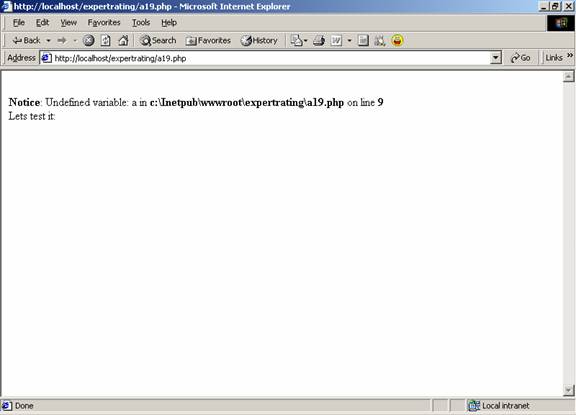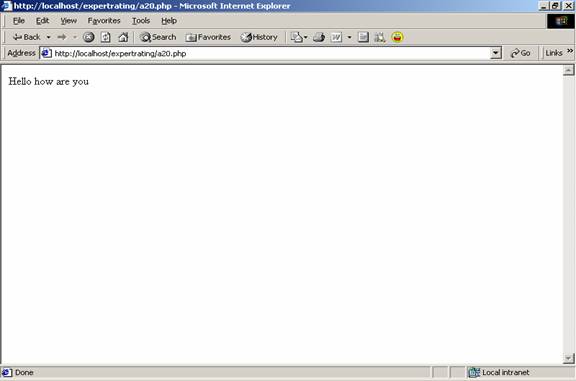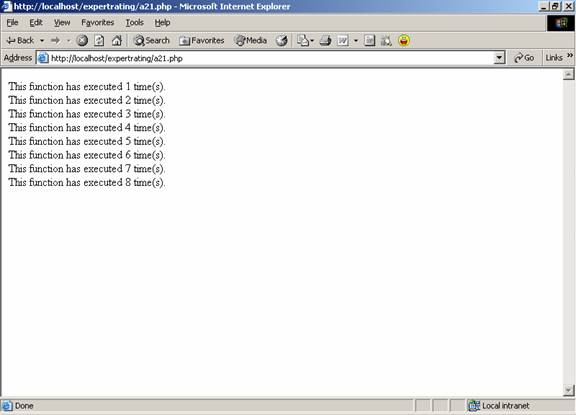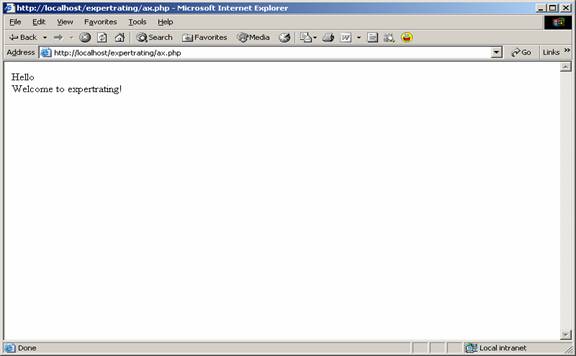- Class: This is a programmer-defined datatype, which
includes local functions as well as local data. You can think of a class
as a template for making many instances of the same kind (or class) of
object.
- Object: An individual instance of the data structure
defined by a class. You define a class once and then make many objects
that belong to it. Objects are also known as instance.
- Member Variable: These are the variables defined inside a
class. This data will be invisible to the outside of the class and can
be accessed via member functions. These variables are called attribute
of the object once an object is created.
- Member function: These are the function defined inside a class and are used to access object data.
- Inheritance: When a class is defined by inheriting
existing function of a parent class then it is called inheritance. Here
child class will inherit all or few member functions and variables of a
parent class.
- Parent class: A class that is inherited from by another class. This is also called a base class or super class.
- Child Class: A class that inherits from another class. This is also called a subclass or derived class.
- Polymorphism: This is an object oriented concept where
same function can be used for different purposes. For example function
name will remain same but it make take different number of arguments and
can do different task.
- Overloading: a type of polymorphism in which some or all
of operators have different implementations depending on the types of
their arguments. Similarly functions can also be overloaded with
different implementation.
- Data Abstraction: Any representation of data in which the implementation details are hidden (abstracted).
- Encapsulation: refers to a concept where we encapsulate all the data and member functions together to form an object.
- Constructor: refers to a special type of function which will be called automatically whenever there is an object formation from a class.
- Destructors: refers to a special type of function which will be called automatically whenever an object is deleted or goes out of scope.
Defining PHP Classes:
The general form for defining a new class in PHP is as follows:
<?php
class phpClass{
var $var1;
var $var2 = "constant string";
function myfunc ($arg1, $arg2) {
[..]
}
[..]
}
?>
|
Here is the description of each line:
- The special form class, followed by the name of the class that you want to define.
- A set of braces enclosing any number of variable declarations and function definitions.
- Variable declarations start with the special form var, which is followed by a conventional $ variable name; they may also have an initial assignment to a constant value.
- Function definitions look much like standalone PHP functions but
are local to the class and will be used to set and access object data.
Example:
Here is an example which defines a class of Books type:
<?php
class Books{
/* Member variables */
var $price;
var $title;
/* Member functions */
function setPrice($par){
$this->price = $par;
}
function getPrice(){
echo $this->price ."<br/>";
}
function setTitle($par){
$this->title = $par;
}
function getTitle(){
echo $this->title ." <br/>";
}
}
?>
|
The variable
$this is a special variable and it refers to the same object ie. itself.
Creating Objects in PHP
Once you defined your class, then you can create as many objects as
you like of that class type. Following is an example of how to create
object using
new operator.
$physics = new Books;
$maths = new Books;
$chemistry = new Books;
|
Here we have created three objects and these objects are independent
of each other and they will have their existance separately. Next we
will see how to access member function and process member variables.
Calling Member Functions
After creating your objects, you will be able to call member
functions related to that object. One member function will be able to
process member variable of related object only.
Following example shows how to set title and prices for the three books by calling member functions.
$physics->setTitle( "Physics for High School" );
$chemistry->setTitle( "Advanced Chemistry" );
$maths->setTitle( "Algebra" );
$physics->setPrice( 10 );
$chemistry->setPrice( 15 );
$maths->setPrice( 7 );
|
Now you call another member functions to get the values set by in above example:
$physics->getTitle();
$chemistry->getTitle();
$maths->getTitle();
$physics->getPrice();
$chemistry->getPrice();
$maths->getPrice();
|
This will produce follwoing result:
Physics for High School
Advanced Chemistry
Algebra
10
15
7
|
Constructor Functions:
Constructor Functions are special type of functions which are called
automatically whenever an object is created. So we take full advantage
of this behaviour, by initializing many things through constructor
functions.
PHP provides a special function called
__construct() to define a constructor. You can pass as many as arguments you like into the constructor function.
Following example will create one constructor for Books class and it
will initialize price and title for the book at the time of object
creation.
function __construct( $par1, $par2 ){
$this->price = $par1;
$this->title = $par2;
}
|
Now we don't need to call set function separately to set price and
title. We can initialize these two member variables at the time of
object creation only. Check following example below:
$physics = new Books( "Physics for High School", 10 );
$maths = new Books ( "Advanced Chemistry", 15 );
$chemistry = new Books ("Algebra", 7 );
/* Get those set values */
$physics->getTitle();
$chemistry->getTitle();
$maths->getTitle();
$physics->getPrice();
$chemistry->getPrice();
$maths->getPrice();
|
This will produce following result:
Physics for High School
Advanced Chemistry
Algebra
10
15
7
|
Destructor:
Like a constructor function you can define a destructor function using function
__destruct(). You can release all the resourceses with-in a destructor.
Inheritance:
PHP class definitions can optionally inherit from a parent class definition by using the
extends clause. The syntax is as follows:
class Child extends Parent {
<definition body>
}
|
The effect of inheritance is that the child class (or subclass or derived class) has the following characteristics:
- Automatically has all the member variable declarations of the parent class.
- Automatically has all the same member functions as the parent,
which (by default) will work the same way as those functions do in the
parent.
Following example inherit Books class and adds more functionality based on the requirement.
class Novel extends Books{
var publisher;
function setPublisher($par){
$this->publisher = $par;
}
function getPublisher(){
echo $this->publisher. "<br />";
}
}
|
Now apart from inherited functions, class Novel keeps two additional member functions.
Function Overriding:
Function definitions in child classes override definitions with the
same name in parent classes. In a child class, we can modify the
definition of a function inherited from parent class.
In the follwoing example getPrice and getTitle functions are overriden to retrun some values.
function getPrice(){
echo $this->price . "<br/>";
return $this->price;
}
function getTitle(){
echo $this->title . "<br/>";
return $this->title;
}
|
Public Members:
Unless you specify otherwise, properties and methods of a class are
public. That is to say, they may be accessed in three possible
situations:
- From outside the class in which it is declared
- From within the class in which it is declared
- From within another class that implements the class in which it is declared
Till now we have seen all members as public members. If you wish to
limit the accessibility of the members of a class then you define class
members as
private or
protected.
Private members:
By designating a member private, you limit its accessibility to the
class in which it is declared. The private member cannot be referred to
from classes that inherit the class in which it is declared and cannot
be accessed from outside the class.
A class member can be made private by using
private keyword infront of the member.
class MyClass {
private $car = "skoda";
$driver = "SRK";
function __construct($par) {
// Statements here run every time
// an instance of the class
// is created.
}
function myPublicFunction() {
return("I'm visible!");
}
private function myPrivateFunction() {
return("I'm not visible outside!");
}
}
|
When
MyClass class is inherited by another class using
extends, myPublicFunction() will be visible, as will $driver. The
extending class will not have any awareness of or access to
myPrivateFunction and $car, because they are declared private.
Protected members:
A protected property or method is accessible in the class in which it
is declared, as well as in classes that extend that class. Protected
members are not available outside of those two kinds of classes. A class
member can be made protected by using
protected keyword infront of the member.
Here is different version of MyClass:
class MyClass {
protected $car = "skoda";
$driver = "SRK";
function __construct($par) {
// Statements here run every time
// an instance of the class
// is created.
}
function myPublicFunction() {
return("I'm visible!");
}
protected function myPrivateFunction() {
return("I'm visible in child class!");
}
}
|
Interfaces:
Interfaces are defined to provide a common function names to the
implementors. Different implementors can implement those interfaces
according to theri requirements. You can say, interfaces are skeltons
which are implemented by developers.
As of PHP5, it is possible to define an interface, like this:
interface Mail {
public function sendMail();
}
|
Then, if another class implemented that interface, like this:
class Report implements Mail {
// sendMail() Definition goes here
}
|
Constants:
A constant is somewhat like a variable, in that it holds a value, but
is really more like a function because a constant is immutable. Once
you declare a constant, it does not change.
Declaring one constant is easy, as is done in this version of MyClass:
class MyClass {
const requiredMargin = 1.7;
function __construct($incomingValue) {
// Statements here run every time
// an instance of the class
// is created.
}
}
|
In this class, requiredMargin is a constant. It is declared with the
keyword const, and under no circumstances can it be changed to anything
other than 1.7. Note that the constant's name does not have a leading $,
as variable names do.
Abstract Classes:
An abstract class is one that cannot be instantiated, only inherited. You declare an abstract class with the keyword
abstract, like this:
When inheriting from an abstract class, all methods marked abstract
in the parent's class declaration must be defined by the child;
additionally, these methods must be defined with the same visibillity.
abstract class MyAbstractClass {
abstract function myAbstractFunction() {
}
}
|
Note that function definitions inside an abstract class must also be
preceded by the keyword abstract. It is not legal to have abstract
function definitions inside a non-abstract class.
Static Keyword:
Declaring class members or methods as static makes them accessible
without needing an instantiation of the class. A member declared as
static can not be accessed with an instantiated class object (though a
static method can).
Try out following example:
<?php
class Foo
{
public static $my_static = 'foo';
public function staticValue() {
return self::$my_static;
}
}
print Foo::$my_static . "\n";
$foo = new Foo();
print $foo->staticValue() . "\n";
|
Final Keyword:
PHP 5 introduces the final keyword, which prevents child classes from
overriding a method by prefixing the definition with final. If the
class itself is being defined final then it cannot be extended.
Following example results in Fatal error: Cannot override final method BaseClass::moreTesting()
<?php
class BaseClass {
public function test() {
echo "BaseClass::test() called<br>";
}
final public function moreTesting() {
echo "BaseClass::moreTesting() called<br>";
}
}
class ChildClass extends BaseClass {
public function moreTesting() {
echo "ChildClass::moreTesting() called<br>";
}
}
?>
|
Calling parent constructors:
Instead of writing an entirely new constructor for the subclass,
let's write it by calling the parent's constructor explicitly and then
doing whatever is necessary in addition for instantiation of the
subclass. Here's a simple example:
class Name
{
var $_firstName;
var $_lastName;
function Name($first_name, $last_name)
{
$this->_firstName = $first_name;
$this->_lastName = $last_name;
}
function toString() {
return($this->_lastName .", " .$this->_firstName);
}
}
class NameSub1 extends Name
{
var $_middleInitial;
function NameSub1($first_name, $middle_initial, $last_name) {
Name::Name($first_name, $last_name);
$this->_middleInitial = $middle_initial;
}
function toString() {
return(Name::toString() . " " . $this->_middleInitial);
}
}
|
In this example, we have a parent class (Name), which has a
two-argument constructor, and a subclass (NameSub1), which has a
three-argument constructor. The constructor of NameSub1 functions by
calling its parent constructor explicitly using the :: syntax (passing
two of its arguments along) and then setting an additional field.
Similarly, NameSub1 defines its nonconstructor toString() function in
terms of the parent function that it overrides.



